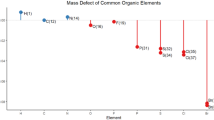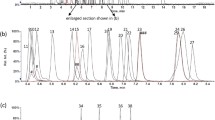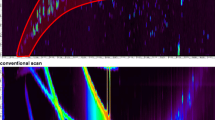Abstract
The high resolution, accurate mass, and fast scanning features of the OrbitrapTM mass spectrometer, combined with the separation power of ultrahigh-performance liquid chromatography were applied for the first time to study the metabolic profiles of several organic flame retardants (FRs) present in indoor dust. To mimic real-life exposure, in vitro cultured HepG2 human hepatocyte cell lines were exposed simultaneously to various FRs in an indoor dust extract for 24 h. Target parent FRs, hexabromocyclododecanes (α-, β-, and γ-HBCDs), tris-2-chloroethyl phosphate (TCEP), tris(1-chloro-2-propyl) phosphate (TCIPP), and tris(1,3-dichloro-2-propyl) phosphate (TDCIPP), were separated in a single run for the first time using alternating positive and negative heated ESI source. Further metabolite separation and identification was achieved using full scan (70,000 full width at half maximum (FWHM)), accurate mass (up to 1 ppm) spectrometry. Structural confirmation was performed via all ion fragmentation (AIF) spectra using the optional higher collisional dissociation (HCD) cell and MS/MS analysis. First insights into human metabolism of HBCDs revealed several hydroxylated and debrominated phase I metabolites, in addition to conjugated phase II glucuronides. Furthermore, various hydroxylated, oxidized, and conjugated metabolites of chlorinated phosphorous FRs were identified, leading to the suggestion of α-oxidation as a significant metabolic pathway for these compounds.

Orbitrap™-MS provides novel insights into human metabolism of flame retardants





Similar content being viewed by others
References
Lokke H, Ragas AMJ, Holmstrup M (2013) Tools and perspectives for assessing chemical mixtures and multiple stressors. Toxicology 313(2–3):73–82. doi:10.1016/j.tox.2012.11.009
Trudel D, Scheringer M, von Goetz N, Hungerbuehler K (2011) Total consumer exposure to polybrominated diphenyl ethers in North America and Europe. Environ Sci Technol 45(6):2391–2397. doi:10.1021/es1035046
Cao ZG, Xu FC, Covaci A, Wu M, Wang HZ, Yu G, Wang B, Deng SB, Huang J, Wang XY (2014) Distribution patterns of brominated, chlorinated, and phosphorus flame retardants with particle size in indoor and outdoor dust and implications for human exposure. Environ Sci Technol 48(15):8839–8846. doi:10.1021/es501224b
Hakk H, Letcher RJ (2003) Metabolism in the toxicokinetics and fate of brominated flame retardants—a review. Environ Int 29(6):801–828
Browne EP, Stapleton HM, Kelly SM, Tilton SC, Gallagher EP (2009) In vitro hepatic metabolism of 2,2 ',4,4 ',5-pentabromodiphenyl ether (BDE 99) in Chinook Salmon (Onchorhynchus tshawytscha). Aquat Toxicol 92(4):281–287. doi:10.1016/j.aquatox.2009.02.017
Stapleton HM, Kelly SM, Pei R, Letcher RJ, Gunsch C (2009) Metabolism of polybrominated diphenyl ethers (PBDEs) by human hepatocytes in vitro. Environ Health Perspect 117(2):197–202. doi:10.1289/ehp.11807
United Nations Environment Programme (UNEP) (2014) Persistent Organic Pollutants Review Committee (POPRC), Reports and Decisions. http://chm.pops.int/TheConvention/POPsReviewCommittee/OverviewandMandate/tabid/2806/Default.aspx
van der Veen I, de Boer J (2012) Phosphorus flame retardants: properties, production, environmental occurrence, toxicity and analysis. Chemosphere 88(10):1119–1153. doi:10.1016/j.chemosphere.2012.03.067
Regnery J, Puettmann W, Merz C, Berthold G (2011) Occurrence and distribution of organophosphorus flame retardants and plasticizers in anthropogenically affected groundwater. J Environ Monitor 13(2):347–354. doi:10.1039/c0em00419g
Regnery J, Puttmann W (2010) Occurrence and fate of organophosphorus flame retardants and plasticizers in urban and remote surface waters in Germany. Water Res 44(14):4097–4104. doi:10.1016/j.watres.2010.05.024
ECHA (2010) European Chemicals Agency: Annex1-Document to RAC opinion on TDCP. http://echaeuropa.eu/documents/10162/0410f4e3-7838-4819-b321-f9d75d3a9cce (accessed 19-6-2012)
Environmental Health Criteria (1995) Tetrabromobisphenol A and derivatives. International Programme on Chemical Safety World Health Organization, Geneva, 172
Van den Eede N, Maho W, Erratico C, Neels H, Covaci A (2013) First insights in the metabolism of phosphate flame retardants and plasticizers using human liver fractions. Toxicol Lett 223(1):9–15. doi:10.1016/j.toxlet.2013.08.012
KEMI (2007) National Chemicals Inspectorate, EU Risk Assessment Report on Hexabromocyclododecane R044_0710_env_hh.doc. R044_0710_env_hhdoc; Sundbyberg, Sweden
Marvin CH, Tomy GT, Armitage JM, Arnot JA, McCarty L, Covaci A, Palace V (2011) Hexabromocyclododecane: current understanding of chemistry, environmental fate and toxicology and implications for global management. Environ Sci Technol 45(20):8613–8623. doi:10.1021/es201548c
Abdallah MA-E, Uchea C, Chipman JK, Harrad S (2014) Enantioselective biotransformation of hexabromocyclododecane by in vitro rat and trout hepatic sub-cellular fractions. Environ Sci Technol 48(5):2732–2740. doi:10.1021/es404644s
Brandsma SH, van der Ven LTM, de Boer J, Leonards PEG (2009) Identification of hydroxylated metabolites of hexabromocyclododecane in wildlife and 28-days exposed wistar rats. Environ Sci Technol 43(15):6058–6063. doi:10.1021/es900879k
Hakk H, Szabo DT, Huwe J, Diliberto J, Birnbaum LS (2012) Novel and distinct metabolites identified following a single oral dose of alpha- or gamma-hexabromocyclododecane in mice. Environ Sci Technol 46(24):13494–13503. doi:10.1021/es303209g
Werner E, Croixmarie V, Umbdenstock T, Ezan E, Chaminade P, Tabet JC, Junot C (2008) Mass spectrometry-based metabolomics: accelerating the characterization of discriminating signals by combining statistical correlations and ultrahigh resolution. Anal Chem 80(13):4918–4932. doi:10.1021/Ac800094p
Alves A, Kucharska A, Erratico C, Xu FC, Den Hond E, Koppen G, Vanermen G, Covaci A, Voorspoels S (2014) Human biomonitoring of emerging pollutants through non-invasive matrices: state of the art and future potential. Anal Bioanal Chem 406(17):4063–4088. doi:10.1007/s00216-014-7748-1
Bandele OJ, Santillo MF, Ferguson M, Wiesenfeld PL (2012) In vitro toxicity screening of chemical mixtures using HepG2/C3A cells. Food Chem Toxicol 50(5):1653–1659. doi:10.1016/j.fct.2012.02.016
Flynn TJ, Ferguson MS (2008) Multiendpoint mechanistic profiling of hepatotoxicants in HepG2/C3A human hepatoma cells and novel statistical approaches for development of a prediction model for acute hepatotoxicity. Toxicol in Vitro 22(6):1618–1631. doi:10.1016/j.tiv.2008.04.016
Kelly JH, Sussman NL (2000) A fluorescent cell-based assay for cytochrome P-450 isozyme 1A2 induction and inhibition. J Biomol Screen 5(4):249–253. doi:10.1089/108705700416119
Jones-Otazo HA, Clarke JP, Diamond ML, Archbold JA, Ferguson G, Harner T, Richardson GM, Ryan JJ, Wilford B (2005) Is house dust the missing exposure pathway for PBDEs? An analysis of the urban fate and human exposure to PBDEs. Environ Sci Technol 39(14):5121–5130
Harrad S, Abdallah MA-E (2011) Brominated flame retardants in dust from UK cars—within-vehicle spatial variability, evidence for degradation and exposure implications. Chemosphere 82(9):1240–1245. doi:10.1016/j.chemosphere.2010.12.038
Abdallah MA, Harrad S (2009) Personal exposure to HBCDs and its degradation products via ingestion of indoor dust. Environ Int 35(6):870–876. doi:10.1016/j.envint.2009.03.002
Abdallah MA, Harrad S (2011) Tetrabromobisphenol-A, hexabromocyclododecane and its degradation products in UK human milk: relationship to external exposure. Environ Int 37(2):443–448. doi:10.1016/j.envint.2010.11.008
Carignan CC, Abdallah MA, Wu N, Heiger-Bernays W, McClean MD, Harrad S, Webster TF (2012) Predictors of tetrabromobisphenol-A (TBBP-A) and hexabromocyclododecanes (HBCD) in milk from Boston mothers. Environ Sci Technol 46(21):12146–12153. doi:10.1021/es302638d
Esslinger S, Becker R, Maul R, Nehls I (2011) Hexabromocyclododecane enantiomers: microsomal degradation and patterns of hydroxylated metabolites. Environ Sci Technol 45(9):3938–3944. doi:10.1021/es1039584
Benedict RT, Stapleton HM, Letcher RJ, Mitchelmore CL (2007) Debromination of polybrominated diphenyl ether-99 (BDE-99) in carp (Cyprinus carpio) microflora and microsomes. Chemosphere 69(6):987–993. doi:10.1016/j.chemosphere.2007.05.010
Butt CM, Wang D, Stapleton HM (2011) Halogenated phenolic contaminants inhibit the in vitro activity of the thyroid regulating deiodinases in human liver. Toxicol Sci. doi:10.1093/toxsci/kfr117
Szabo DT, Richardson VM, Ross DG, Diliberto JJ, Kodavanti PRS, Birnbaum LS (2009) Effects of perinatal PBDE exposure on hepatic phase I, phase II, phase III, and deiodinase 1 gene expression involved in thyroid hormone metabolism in male rat pups. Toxicol Sci 107(1):27–39
Holcapek M, Kolarova L, Nobilis M (2008) High-performance liquid chromatography-tandem mass spectrometry in the identification and determination of phase I and phase II drug metabolites. Anal Bioanal Chem 391(1):59–78. doi:10.1007/s00216-008-1962-7
Burka LT, Sanders JM, Herr DW, Matthews HB (1991) Metabolism of tris(2-chloroethyl) phosphate in rats and mice. Drug Metab Dispos 19(2):443–447
Chapman DE, Michener SR, Powis G (1991) Metabolism of the flame-retardant plasticizer tris(2-chloroethyl)phosphate by human and rat-liver preparations. Fundam Appl Toxicol 17(2):215–224. doi:10.1016/0272-0590(91)90214-o
Stubbings WA, Harrad S (2014) Extent and mechanisms of brominated flame retardant emissions from waste soft furnishings and fabrics: a critical review. Environ Int 71:164–175. doi:10.1016/j.envint.2014.06.007
Lynn RK, Wong K, Garviegould C, Kennish JM (1981) Disposition of the flame-retardant, tris(1,3-dichloro-2-propyl) phosphate, in the rat. Drug Metab Dispos 9(5):434–441
Cooper E, Stapleton H (2011) Metabolism of organophosphate flame retardants by human liver microsomes and porcine esterase. SETAC North America 32nd Annual Meeting http://orbit.dtu.dk/fedora/objects/orbit:105810/datastreams/file_6352082/content:176
Acknowledgments
The research leading to these results has received funding from the European Union Seventh Framework Programme FP7/2007-2013 under grant agreements PIIF-GA-2012-327232 (ADAPT project), 316665 (A-TEAM project), and 264600 (INFLAME project).
Author information
Authors and Affiliations
Corresponding author
Electronic supplementary material
Further details on analytical method optimization, QA/QC measurements and structural confirmation of metabolites are provided as electronic supplementary material.
ESM 1
(PDF 136 kb)
Rights and permissions
About this article
Cite this article
Abdallah, M.AE., Zhang, J., Pawar, G. et al. High-resolution mass spectrometry provides novel insights into products of human metabolism of organophosphate and brominated flame retardants. Anal Bioanal Chem 407, 1871–1883 (2015). https://doi.org/10.1007/s00216-015-8466-z
Received:
Revised:
Accepted:
Published:
Issue Date:
DOI: https://doi.org/10.1007/s00216-015-8466-z




